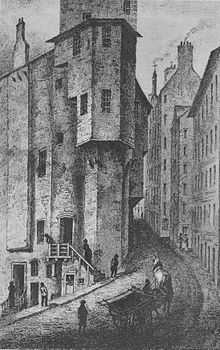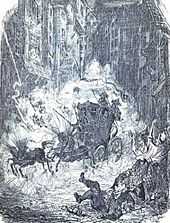Thomas Weir

Major Thomas Weir (Carluke, South Lanarkshire 1599 – Edinburgh 1670) was a Scottish soldier and presumed occultist, executed for witchcraft.
Weir was a Covenanter who professed a particularly strict form of Presbyterianism. His spoken prayers earned him a reputation for religiosity which attracted visitors to his home in Edinburgh. He served under James Graham, Marquis of Montrose, as a lieutenant in the Army of the Covenant. He was known as the "Bowhead Saint",[1] because his residence was near the top of the West Bow, off the Grassmarket, and "saint" was a popular epithet for Calvinist zealots.
Biography
Weir was a native of Carluke (Kirkstyle) in Lanarkshire, descendant of one of the most powerful and ancient families of the County, the Weir-de Veres. He was the son of Thomas Weir, Laird of Kirkton, and his wife Lady Jean Somerville who was reputed to possess clairvoyant powers. His grandfather was William Weir, or Vere, of Stonebyres Castle who married Lady Elizabeth Hamilton. Weir was a signatory to the Solemn League and Covenant and an officer in the Scottish anti-Royalist army. As a Lieutenant, he served in Ulster during the Irish Rebellion of 1641. In 1650, he obtained the post of commander of the Edinburgh Town Guard, thus acquiring the rank of major. When the defeated royalist general Montrose—branded a traitor for changing sides—was brought to Edinburgh for execution, Weir notoriously mocked and abused him during his custody.[2]
Following retirement, Weir fell ill in 1670, and from his sick-bed began to confess to a secret life of crime and vice. The Lord Provost initially found the confession implausible and took no action, but eventually Weir and his spinster sister, Jean Weir (known to her friends as 'Grizel'), were taken to the Edinburgh Tolbooth for interrogation. Major Weir, now in his seventies, continued to expand on his confession and Grizel, having seemingly entirely lost her wits, gave an even more exaggerated history of witchcraft, sorcery and vice. She related how many years before a stranger had called in a "fiery" coach to take her brother to Dalkeith and how during the short trip another man had given him "supernatural intelligence" (Chambers) of the Scots' defeat at Worcester that same day.[3] (In fact, Cromwell's Commonwealth Commissioners in Scotland had been based in Dalkeith and would have been among the first to know the outcome of the battle—though not, of course, on the same day.) Grizel maintained that Weir derived his power from his walking stick, topped by a carved human head, giving rise to later accounts that it had often been seen parading down the street in front of him.

Whilst as a high-ranking public figure Weir was not believed at first, his own confession together with that of his sister sealed his fate. Both were quickly found guilty at their trial and sentenced to death. [2]
While awaiting execution, they were confined in the former leper colony at Greenside below the Calton Hill. Weir was garrotted and burned at the Gallowlee[4] (literally, "gallows field") on the road between Edinburgh and Leith[5] (a site later occupied by the Shrubhill tram depot, then bus garage, near Pilrig on Leith Walk). His last words, while being urged to pray for forgiveness, were reported as, "Let me alone—I will not—I have lived as a beast, and I must die as a beast".[6] Weir's stick was consigned to the flames after him, reportedly making "rare turnings" in the fire. Shortly before his end Weir had made a further public confession of incest with his sister, who was executed in the Grassmarket.[7] The remains of the Weirs were buried at the base of the gallows at Shrub Hill, as was the custom of the time.
Legacy
The Weirs' house in the West Bow stood empty for over a century because of its reputation for being haunted. It was said that one of Weir's enchantments made people ascending the stair think they were descending in the opposite direction.[8] It was eventually bought cheaply in about 1780 by an ex-soldier William Patullo who moved in with his wife. They are said to have fled the house on their first night there after experiencing a strange apparition of a calf approaching them in the night, propping itself up with its forelegs on the bed-end and staring at them in bed.[9] According to Walter Scott, the house, which remained unoccupied after the incident, was demolished in 1830.
The story of Weir has been proposed as an influence on Dr Jekyll and Mr Hyde, by Robert Louis Stevenson.[10] The 2000 novel The Fanatic by James Robertson features Weir as a character and uses the events surrounding him as a central aspect of the novel's narrative and themes.
References
- ↑ Clan Weir
- ↑ 2.0 2.1 James Grant, Cassell's Old and New Edinburgh, a partwork published by Cassells from 1880.
- ↑ Chambers, R (1824). Traditions of Edinburgh. Edinburgh: W & R Chambers Ltd. reprint 1980. p. 33. ISBN 0 550 21292 2.
- ↑ Edinburgh and The Lothians
- ↑ Grassmarket – Edinburgh.Com – History- Major Thomas Weir
- ↑ Sittwell, S; Bamford, F (1938). Edinburgh. London: Faber & Faber. p. 165.
- ↑ Major Weir Scottish Clans Tartans Kilts Crests and Gifts
- ↑ Sittwell, S; Bamford, F (1938). Edinburgh. London: Faber & Faber. p. 164.
- ↑ Chambers, R (1824). Traditions of Edinburgh. Edinburgh: W & R Chambers Ltd. reprint 1980. p. 35. ISBN 0 550 21292 2--Sittwell and Bamford describe the calf as headless but give no supporting source.
- ↑ .BBC – Press Office – Ian Rankin investigates Dr Jekyll and Mr Hyde for BBC Four
Further reading
- David Stevenson, Major Weir: a justified sinner?, Scottish Studies, 16 (1972)
External links
 "Weir, Thomas". Dictionary of National Biography. London: Smith, Elder & Co. 1885–1900.
"Weir, Thomas". Dictionary of National Biography. London: Smith, Elder & Co. 1885–1900. - Major Thomas Weir
- Witches and Witch Trials in Scotland